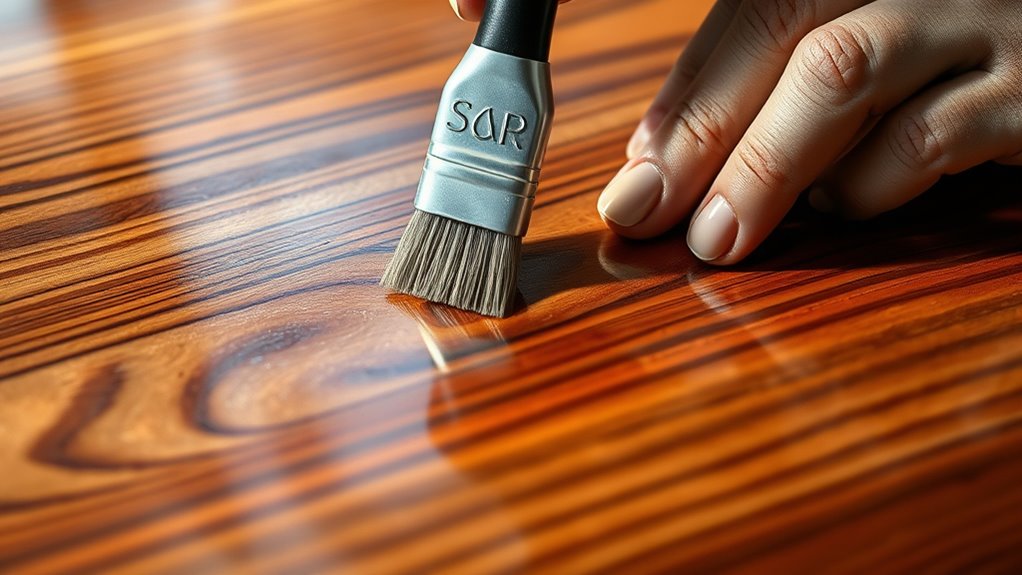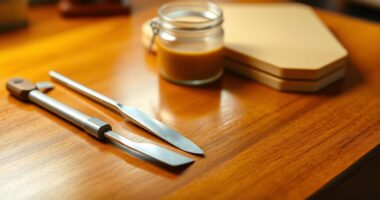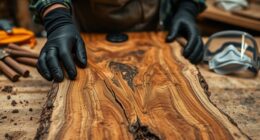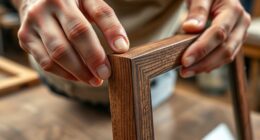French polishing is a traditional skill that gives wood a stunning, mirror-like high-gloss finish. You prepare the surface properly by sanding and removing previous coatings, then apply thin layers of shellac with soft cloths or rubber pads, working along the grain. Patience is key—allow each coat to dry before adding another and gently buff for brilliance. Mastering these delicate techniques reveals the natural beauty of your wood, and the detailed process is worth exploring further.
Key Takeaways
- Prepare the wood surface thoroughly with sanding to ensure smoothness and proper shellac adhesion.
- Apply multiple thin layers of shellac using soft cloths or polishing pads, following the wood grain for even coverage.
- Use specialized tools like rubber pads for detailed areas and gentle polishing techniques to build gloss and depth.
- Allow sufficient drying time between coats, gradually increasing layers for durability and a high-gloss finish.
- Finish with gentle buffing using soft cloths to achieve a luminous, mirror-like surface characteristic of traditional French polishing.
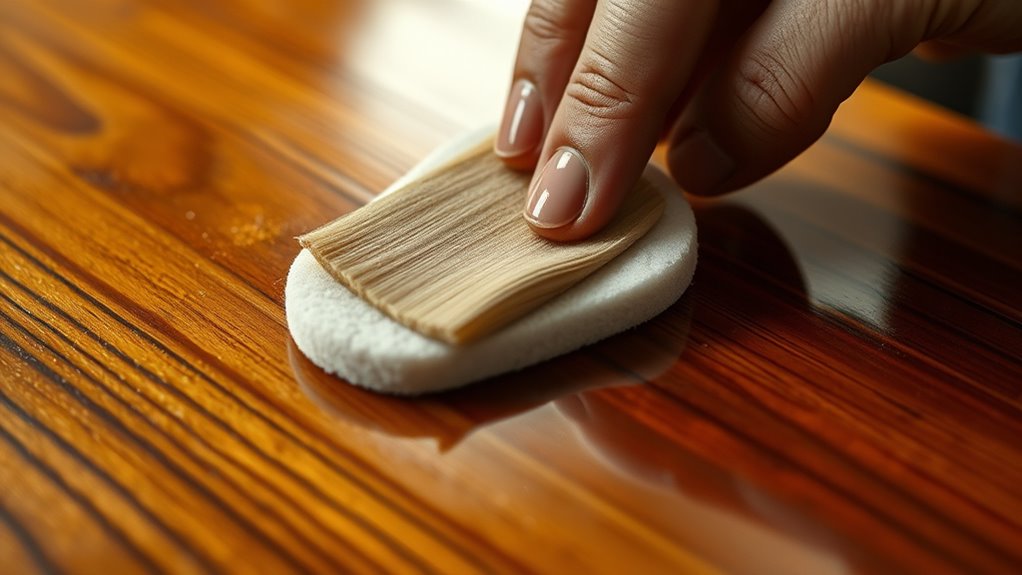
French polishing is a traditional finishing technique that restores and enhances the beauty of wood surfaces. When you decide to apply this method, you’re embracing a craft that has been refined over centuries. The process highlights the natural wood grain, revealing its unique patterns and depth, which adds a sophisticated, high-gloss finish to your piece. To achieve this, you’ll need the right finishing tools, such as fine cloths, rubber pads, and polishing compounds. These tools allow you to work delicately and precisely, ensuring the wood’s surface remains smooth and glowing.
French polishing enhances wood’s natural grain with a high-gloss, durable finish using delicate tools.
Your first step is preparing the wood surface properly. You should sand it evenly, removing any rough patches or previous finishes. Once the surface is smooth, you can start applying a thin layer of shellac with a polishing pad or a soft cloth. As you work, pay close attention to the wood grain, following its natural direction. This helps the shellac settle into the wood’s pores and enhances the grain’s intricate details. The key is to work slowly and carefully, building up multiple thin layers rather than one thick coat. This approach ensures a more even, glossy finish and reduces the risk of drips or uneven patches.
Throughout the process, your choice of finishing tools plays a critical role. Using a soft, lint-free cloth allows you to apply the shellac evenly and smoothly. A rubber polishing pad can help you work into tight corners or curved surfaces, maintaining consistency across the entire piece. As each layer dries, you can gently smooth out any imperfections with a fine abrasive or a soft cloth, preparing the surface for the next coat. The repeated application and careful buffing bring out the depth of the wood grain, creating a luminous, mirror-like surface that accentuates the natural beauty of your wood. Additionally, understanding that attention is essential to cultivating patience and precision can significantly improve the quality of your finish.
Patience is essential in French polishing. Each coat needs adequate drying time, and you should avoid rushing the process. Over time, the layers build up, creating a durable, high-gloss finish that’s both attractive and protective. When you finally reach the desired sheen, a final buff with a clean, soft cloth will bring out the full brilliance of the polish. The result is a stunning, smooth surface that showcases your craftsmanship and highlights the wood’s natural grain. With the right finishing tools and careful attention to detail, you can create a piece that radiates elegance and timeless appeal.
Frequently Asked Questions
What Types of Wood Are Best Suited for French Polishing?
You should choose hardwoods like mahogany, rosewood, or maple for French polishing, as their fine wood grain allows for a smooth, even finish. These woods also provide better finish durability, ensuring your high-gloss surface remains stunning over time. Softer woods aren’t ideal because they can absorb more polish unevenly, leading to a less durable and less glossy result. Stick with these hardwoods for the best French polishing outcome.
How Long Does a Typical French Polishing Process Take?
A typical French polishing process takes about 10 to 15 hours, but it can extend to several days depending on the application duration and drying time needed between coats. You’ll apply thin layers of shellac, allowing each to dry thoroughly. Patience is key—skipping drying time can compromise the high-gloss finish. Expect multiple coats, with drying time usually ranging from 30 minutes to a few hours per layer.
Can French Polishing Be Repaired if Damaged?
Yes, you can repair French polishing if it gets damaged. Restoration techniques like careful reapplication of shellac and polishing can seamlessly blend repairs with the original finish. To prevent future damage, it’s essential to handle the surface gently, avoid exposure to moisture, and regularly maintain the finish. Proper care guarantees your high-gloss surface stays stunning and minimizes the need for repairs.
What Safety Precautions Are Necessary During French Polishing?
A stitch in time saves nine, so prioritize safety during French polishing. You must wear personal protective equipment like gloves and a mask to shield yourself from fumes and chemicals. Make certain proper ventilation to prevent inhaling harmful vapors. Work in a well-ventilated area, and avoid open flames or sparks. Following these precautions keeps you safe while achieving that perfect high-gloss finish with traditional techniques.
How Does French Polishing Compare to Modern Finishing Methods?
French polishing offers a stunning, deep high-gloss finish that many still prefer, but modern finishing methods can provide quicker results and greater durability. While traditional techniques excel at achieving a rich, nuanced sheen, they often lack the durability of contemporary finishes like polyurethane or lacquer. You’ll find that modern sheen options are more resistant to wear and moisture, making them practical choices for high-traffic or outdoor furniture.
Conclusion
As you master the art of French polishing, you’ll realize it’s more than just technique—it’s a reflection of patience and dedication. Sometimes, the perfect high-gloss finish appears unexpectedly, reminding you that beauty often arises from careful, persistent effort. Embrace the process, and you’ll find that the surface’s gleam mirrors your own commitment. In mastering this craft, you discover that true elegance is born not just from the polish, but from the passion behind it.
